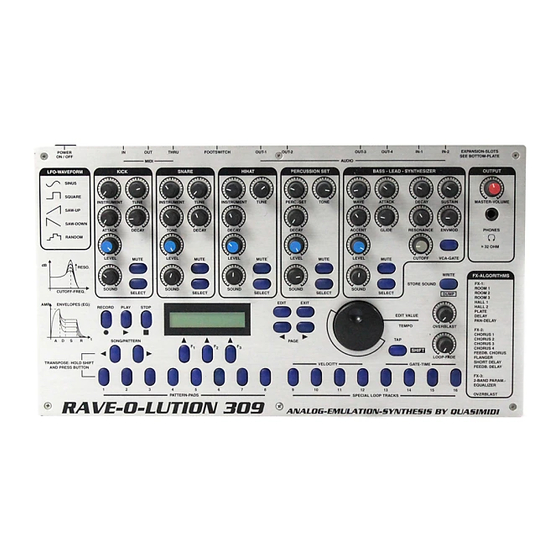Table of Contents
Advertisement
Quick Links
Advertisement
Table of Contents

Summary of Contents for Quasimidi Rave-O-Lution 309
- Page 32 RAVE-O-LUTION 309 AUDIO-EXPANSION QUASIMIDI...
- Page 33 - Protect the board and IC from electrostatic discharge. - Operate the board only in the RAVE-O-LUTION 309. QUASIMIDI does not assume responsibility for damage resulting from mishandling or improper installation procedures. This product is under warranty from the factory for a period of 6 months.
- Page 34 Introduction Introduction: Congratulations on the purchase of the Audio I/O Expansion. This package will increase the functionality of your Rave-O-Lution 309 tremendously. The following new features are at your disposal after installation: 2 additional polyphonic audio outputs. 2 additional audio inputs for treatment of external sound sources using two complete A.E.S.
- Page 35 Installationguide Included in the package, besides this manual, are following items: 6 countersunk Phillips screws 4 plastic nuts 4 small thread screws 4 washers 1 EPROM with OS 2.0 in anti- static foam material I/O-Board incl. Cable IC removing tool Check to see all the items listed above are included in the package.
- Page 36 Installationguide e.) Using the IC tool, remove the chip. To remove the IC from the socket, place the IC tool at the both ends of the IC. Be careful to place it directly under the IC, not under the socket. Pull carefully, alternating from the left and right sides, and remove the chip.
- Page 37 Installationguide Instalation of I/O-Board: 1.) Remove the 6 screws from the Frontpanel of the 309. The arrows show the position of the screws. 2.) Carefully lift the Frontpanel. Don't you forget the position of the cable on the right handed volume- knob-board (red marked cable).
- Page 38 Installationguide 4.) Remove the screws from the outside of the body. These screws fix the metal sheet where the I/O- Expansion will be placed. 5.) Place the jacks of the I/O-Board through the 4 holes. 6.) Fix the Board with the included 4 screws.
- Page 39 Installationguide 7.) Now the attached cable on the I/O-Board must be connected with the Mainboard of the 309. There is just one way to connect the cable with the "AUDIOEXP" named connector on the Mainboard because it is already pre-bent. 8.) In this step you have to fix the 4 jacks of the I/O-Board with the included 4 plastic nuts.
- Page 40 The Audio-Inputs Initialization of the 309: After changing the OS of the 309 it is necessary to initialize the instrument. Otherwise the I/O- Expansion will not be recognized. With the 309 turned off, press and hold the "WRITE"-Button of the 309 while you switch the power on.
- Page 41 The Audio-Inputs Editing of the Input Sections: For each of the two Audio Inputs IN-1 and IN-2 you have a complete A.E.S. synthesis section available. This means, you can treat (affect) the external sound-sources with the same parameters, which previously were only for internal use on your instrument. As there are no separate pots on the front panel for the inputs, thefollowing will show you how to access these new parameters.
- Page 42 The Audio-Inputs Edit Mix T: Ext1 <2> Pan: OUT2 Here you can set the pan position for the sound-source on IN-1. You will now find another new feature of the expansion card, which also affects the MIX menu of the other Instrument sections. When panning an instrument or your external sound source all the way left, the sound will output only via OUT 2 (LEFT) of the 309.
- Page 43 Assignement of individual Outputs inputs allows the creation of very complex Gater effects. The menu pages 6-26 contain all the parameters, which are also provided by the BASS-LEAD- SYNTHESIZER section. After installation of the Audio Expansion you lose access to the parameters on pages 6, 19, 20 and 24.
- Page 44 New functions of the WRITE-Menu Now the Kick is only sent out via OUT4. Turning back the EDIT VALUE Dial one step, you will see OUT 3. Once an instrument has been assigned to one of the individual outs, this assignment is maintained even after a pattern or song change.
- Page 45 New functions of the WRITE-Menu: Kick-Motif 0 [ok] [cancel] Now you can select the memory location to which you'd like to copy the motif to. Empty storage locations are indicated via a little star in the display: Kick*Motif 1 [ok] [cancel] Once you confirm [ok] the motif is being stored in the new location.
- Page 46 New Sequencer functions Realtime-Loop-Recording: The most important innovation can be found in the Drumgrid. You'd best try this new function with a completely initialized pattern (Init Patt. on page 5 of the Write Menu). Go to the Edit- Pattern-Menu and call up the Drumgrid. The first new feature is that you are able to access the different sections via the SELECT button without leaving the drum grid.
- Page 47 DEALER DISTRIBUTOR...
- Page 48 Initialization of the 309: How to sync the LFO with the sequencer? age will increase the functionality of your RAVE-O-LUTION 309 tre- After changing the operating system of the 309 it is necessary to Insert the the new IC on the socket without pressing.
- Page 49 LFO (Low Frequency Oscillator). recommend consulting your authorized QUASIMIDI-dealer or the You will find it in the sound-edit menus of each section upwards Percussion-Instruments QUASIMIDI-distributor for your country.




Need help?
Do you have a question about the Rave-O-Lution 309 and is the answer not in the manual?
Questions and answers